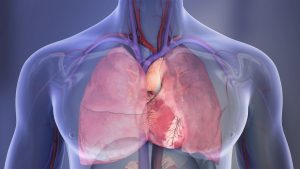
Effective antiretroviral therapy has changed the human immunodeficiency virus (HIV) from a progressive, fatal disease to a chronic, manageable condition associated with higher rates of heart attacks, strokes, heart failure, sudden cardiac deaths, and other diseases compared to people without HIV, according to a new scientific statement from the American Heart Association published in the Association journal Circulation.
People living with HIV are at increased risk of heart and blood vessel diseases because of interactions between traditional risk factors, such as diet, lifestyle and tobacco use, and HIV-specific risk factors, such as a chronically activated immune system and inflammation characteristic of chronic HIV.
Tobacco use, a major risk factor for cardiovascular diseases, is common among people living with HIV. In a nationally representative U.S. sample, 42 percent of people living with HIV were current smokers. Heavy alcohol use, substance abuse, mood and anxiety disorders, low levels of physical activity and poor cardiorespiratory fitness are also common among people living with HIV and may contribute to elevated risk for diseases of the heart and blood vessels, according to the statement.
“Considerable gaps exist in our knowledge about HIV-associated diseases of the heart and blood vessels, in part because HIV’s transition from a fatal disease to a chronic condition is relatively recent, so long-term data on heart disease risks are limited,” said Matthew J. Feinstein, M.D., M.Sc.
In addition, people living with HIV are often stigmatized and face significant barriers to optimal health care, such as education level, where they live, healthcare literacy, disenfranchisement from the healthcare system, cognitive impairment, injection drug use, internalized and anticipated stigma, gait and mobility impairment, frailty, depression and social isolation. There are also disparities in care based on age, race, ethnicity and gender.
Another area of concern is the aging population of people living with HIV – 75 percent of people living with HIV are over age 45.
“Aging with HIV differs greatly from the aging issues facing the general population,” said Jules Levin, M.S., in an accompanying patient perspective.
Levin has been living with HIV for 35 years and is the founder and executive director of the National AIDS Treatment Advocacy Project.
“On average, people living with HIV who are over 60 years old have 3-7 medical conditions, including heart attacks, strokes, heart failure, kidney disease, frailty and bone diseases and many take 12-15 medications daily. As they age, people living with HIV are often alone and disabled, emotionally homebound due to depression, and are socially isolated. In addition, they often suffer from lack of mobility and an impaired ability to perform normal daily functions. We urgently need better awareness and more patient-focused research and care efforts for this vulnerable population,” said Levin.
Providing scientifically based recommendations on how to reduce the risk of cardiovascular disease among people living with HIV is also challenging.
To keep people living with HIV healthy, Feinstein emphasizes the importance of a healthy lifestyle that includes smoking cessation, adequate physical activity, eliminating or reducing the amount of alcohol consumed and a healthy diet. In addition, medications such as statin drugs, which lower cholesterol, and other medications that make blood less likely to form clots may be helpful, although more clinical trial data are needed.








